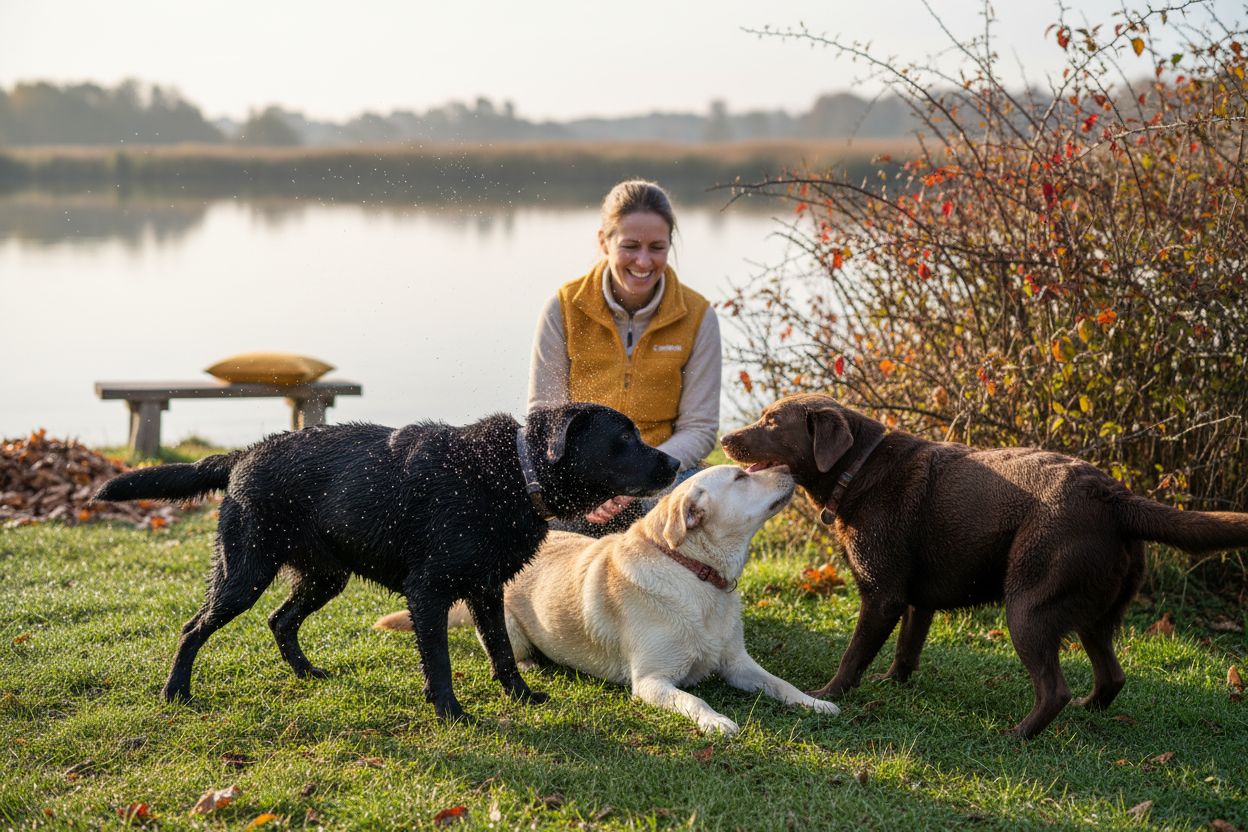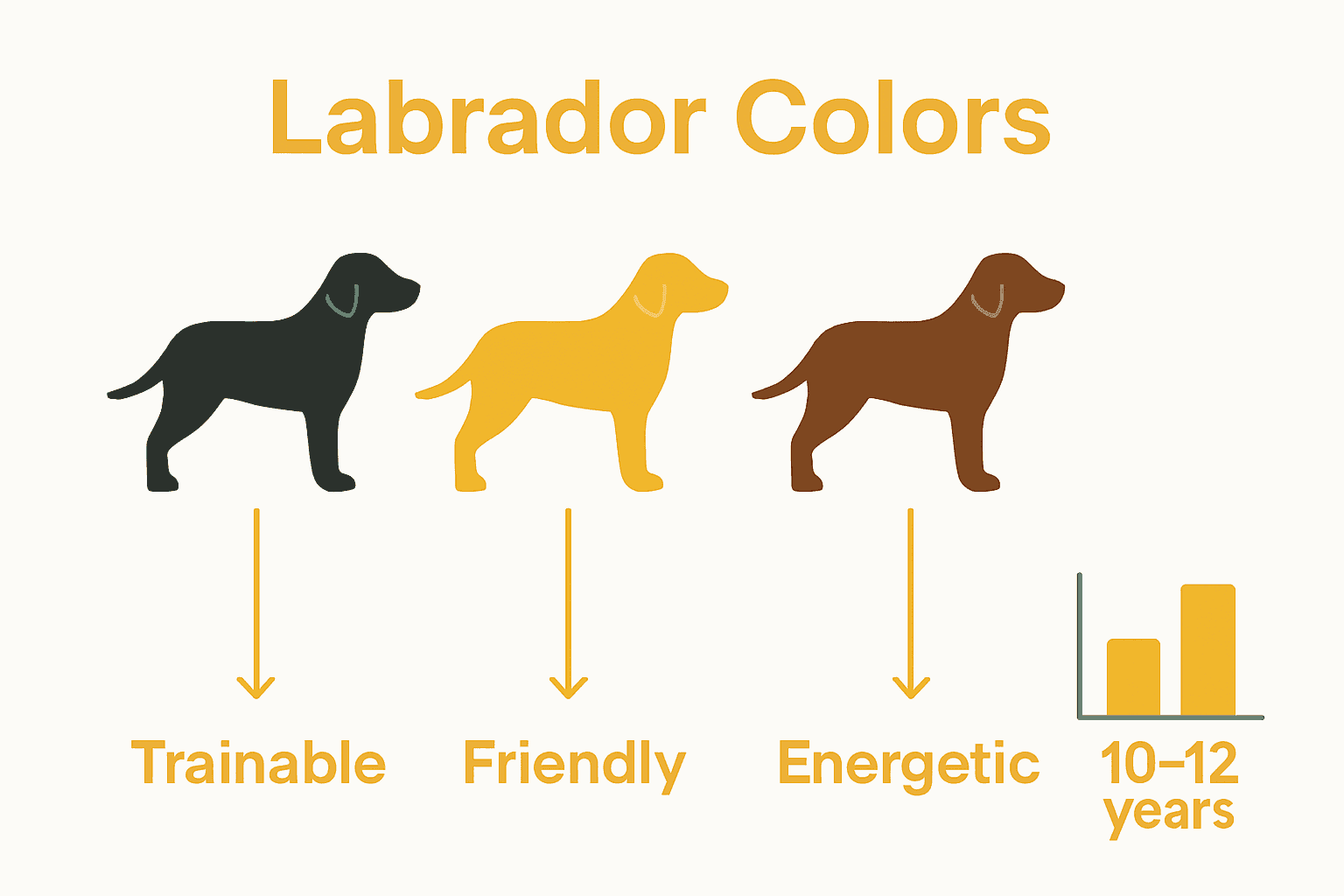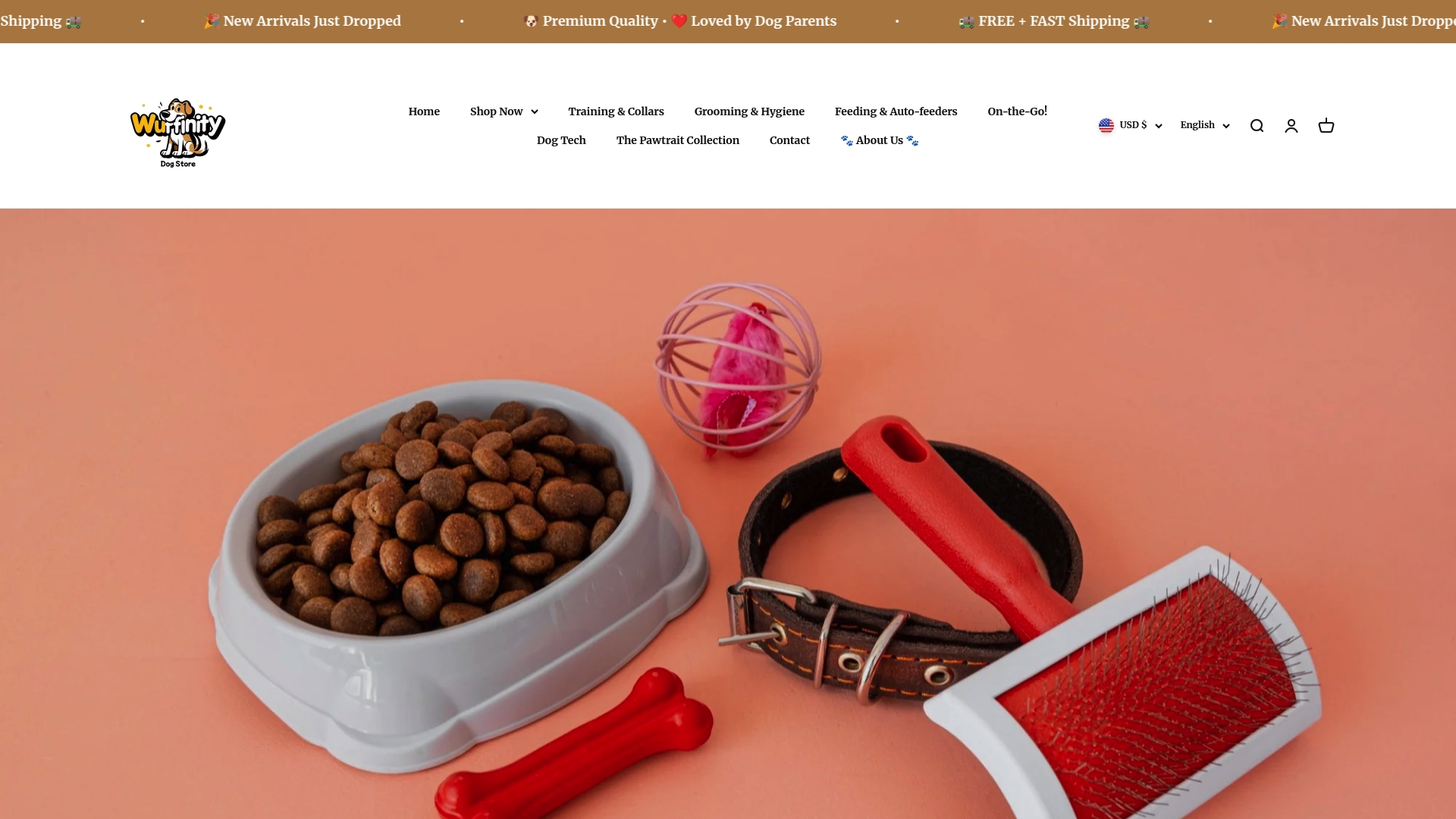Did you know the Labrador Retriever has been the most popular dog breed in the world for over three decades? Their winning mix of loyalty, intelligence, and adaptable temperament makes them favorites in both family homes and demanding working roles. From their sturdy build to their affectionate nature, Labradors stand out as loyal companions and dedicated workers, drawing on a fascinating history and traits that continue to capture hearts everywhere.
Key Takeaways
| Point | Details |
|---|---|
| Origin and Purpose | Labrador Retrievers originated from St. John’s water dogs in the UK, developed for working closely with fishermen. |
| Temperament and Trainability | Renowned for their intelligence and gentle disposition, Labradors excel as family pets, therapy dogs, and service animals. |
| Grooming and Exercise Needs | Regular grooming and 60-90 minutes of daily exercise are crucial to maintaining their health and well-being. |
| Health Considerations | Labradors are prone to obesity and other health issues; responsible ownership includes genetic screening and proactive healthcare. |
Table of Contents
- What Defines A Labrador Retriever
- Labrador Coat Types And Origins
- Physical Traits And Temperament
- Essential Grooming And Exercise Needs
- Nutrition And Feeding Guidelines
- Common Health Issues And Lifespan
- Training Needs And Behavioural Traits
- Choosing A Labrador Responsibly
What Defines A Labrador Retriever
The Labrador Retriever is more than just a popular family dog - it’s a breed with a rich history and distinctive characteristics that set it apart from other canine companions. According to research from The Kennel Club, this remarkable breed originated in the United Kingdom, specifically developed from St. John’s water dogs imported from Newfoundland. These working dogs were originally bred for a critical purpose: assisting fishermen by retrieving nets, pulling ropes, and even rescuing people from cold waters.
Labrador Retrievers are defined by several key physical and temperamental traits that make them exceptional companions and working dogs:
- Medium to Large Size: Typically weighing between 55-80 pounds
- Three Primary Coat Colors: Black, yellow, and chocolate
- Dense, Water-Resistant Double Coat: Perfectly adapted for swimming and cold environments
- Muscular, Athletic Build: Designed for both work and play
A comprehensive veterinary study confirms the breed’s extraordinary global popularity, highlighting not just their physical attributes but their remarkable temperament. Labradors are renowned for their intelligence, high trainability, and gentle disposition. They excel in multiple roles - from family pets and therapy dogs to search and rescue workers, hunting companions, and service animals for individuals with disabilities. Their versatility and consistently friendly nature have made them one of the most beloved dog breeds worldwide.
Labrador Coat Types And Origins
The Labrador Retriever’s distinctive coat is one of its most recognizable features, telling a story of both functionality and genetic diversity. According to Wikipedia’s research on Labrador Retrievers, these dogs possess a unique double-coat system that emerged in the late 1800s, featuring three primary color variations: black, yellow (ranging from cream to fox-red), and chocolate.
These coat colors aren’t just aesthetic choices - they’re deeply rooted in the breed’s working heritage. The double-coat serves multiple critical purposes:
- Water Resistance: Protects the dog during swimming and in cold environments
- Temperature Regulation: Keeps the dog warm in cold conditions and cool in warmer weather
- Physical Protection: Guards against external elements like brambles and rough terrain
Interestingly, the yellow and chocolate variants didn’t always exist. Initially, black was the predominant color, with yellow and liver (chocolate) coats emerging later through careful breeding. The winter dog jacket might complement a Labrador’s natural coat, but these dogs are already magnificently equipped for various weather conditions. Their short, dense fur is not just beautiful but a testament to generations of breeding focused on creating the ultimate working and companion dog.

Physical Traits And Temperament
Labrador Retrievers are renowned for their distinctive physical characteristics that perfectly balance strength, agility, and aesthetic appeal. According to Wikipedia’s detailed breed description, these dogs typically stand 21-24 inches tall and weigh between 55-80 pounds, with a body structure that’s equally long as their shoulder height. Their muscular build reflects their historic working dog origins, designed for demanding tasks like retrieving game, swimming, and providing assistance.
Key physical characteristics include:
- Robust Skeletal Structure: Strong, well-proportioned frame
- Broad Head: Wide skull with intelligent, expressive eyes
- Powerful Hindquarters: Enables exceptional jumping and swimming capabilities
- Thick, Otter-like Tail: Used for balance and swimming propulsion
When it comes to temperament, Labradors are nothing short of extraordinary. As research indicates, they are globally recognized for their exceptional intelligence, boundless energy, and remarkably gentle disposition. These traits make them not just fantastic family companions but also highly effective working dogs in fields like understanding dog collar selection, police work, search and rescue, and therapy assistance. Their ability to combine high-energy performance with a patient, loving demeanor makes them one of the most adaptable and beloved dog breeds in the world.
Essential Grooming And Exercise Needs
Grooming a Labrador is both an art and a necessity, given their unique double-coat characteristics. According to PetMD’s comprehensive guide, Labradors have a water-repellent coat that sheds heavily, requiring consistent and strategic grooming approaches. Regular brushing isn’t just about keeping your dog looking good - it’s crucial for managing their substantial seasonal shedding and maintaining coat health.
Grooming essentials for Labradors include:
- Weekly Brushing: Removes loose fur and distributes natural skin oils
- Monthly Bathing: Keeps coat clean without stripping natural protectants
- Nail Trimming: Prevents overgrowth and potential walking discomfort
- Ear Cleaning: Prevents potential infections common in floppy-eared breeds
Exercise is equally critical for Labradors. A groundbreaking veterinary study highlighted that Labradors are prone to obesity, making regular physical activity paramount. These dogs were bred as working retrievers and have substantial energy reserves that need consistent outlets. Check out our guide on outdoor dog gear to help you plan exciting activities like swimming, hiking, fetch games, and agility training. Aim for at least 60-90 minutes of active movement daily to keep your Labrador physically fit and mentally stimulated, preventing weight-related health complications and ensuring a happy, thriving companion.
Here’s a summary of Labrador Retriever care essentials:
| Aspect | Main Needs | Key Recommendations |
|---|---|---|
| Grooming | Weekly brushing Monthly bathing |
Maintain coat health Control shedding |
| Exercise | 60-90 min/day Varied activities |
Include swimming, hiking, fetch |
| Nutrition | High-quality protein Lean diet |
Portion control Omega-3s for joints |
| Health Checks | Regular vet visits Genetic screening |
Monitor weight Check ears/eyes |
Nutrition And Feeding Guidelines
Nutrition plays a pivotal role in a Labrador’s overall health and longevity, with research revealing fascinating insights into dietary impacts. According to a comprehensive study published in veterinary research, controlled nutrition can significantly influence a Labrador’s lifespan and quality of life. The research demonstrated that dogs maintained in lean body condition lived approximately 15% longer and experienced delayed onset of age-related diseases like osteoarthritis.
Key nutritional considerations for Labradors include:
- High-Quality Protein: Support muscle maintenance and development
- Balanced Calorie Intake: Prevent obesity, a common breed challenge
- Omega-3 Fatty Acids: Promote joint health and coat condition
- Complex Carbohydrates: Provide sustained energy for their active lifestyle
Feeding strategies should be tailored to your Labrador’s age, activity level, and individual metabolism. Puppies, adults, and senior dogs have distinctly different nutritional requirements. Our guide on dog grooming accessories can help you understand how nutrition impacts overall health. Portion control is critical - Labradors are notorious for their food-motivated nature and can easily become overweight. Consult with a veterinarian to develop a personalized feeding plan that maintains optimal body condition, supports their high energy needs, and promotes long-term health and vitality.
Common Health Issues And Lifespan
Labrador Retrievers are beloved companions with a typical lifespan of 12-13 years, though their health journey can be influenced by genetics, diet, and preventive care. According to Wikipedia’s breed research, there are notable variations in longevity, with chocolate-colored Labradors demonstrating approximately 10% shorter lifespans compared to their black and yellow counterparts.
Common health challenges for Labradors include:
- Degenerative Joint Disease: Particularly in older dogs
- Obesity-Related Complications: Highest risk among all dog breeds
- Ear Infections: Frequent in floppy-eared dogs
- Genetic Eye Conditions: Progressive retinal atrophy
- Hip and Elbow Dysplasia: Structural joint problems
A comprehensive UK veterinary study revealed critical insights into breed-specific health patterns. While Labradors are generally robust, they require meticulous health monitoring. Explore our dog travel gear checklist to help manage your dog’s health during travels. Proactive strategies like maintaining a lean body weight, regular veterinary check-ups, appropriate exercise, and genetic screening can significantly enhance your Labrador’s quality of life and potentially extend their lifespan beyond the average 12-year expectancy.

Training Needs And Behavioural Traits
Labrador Retrievers are renowned for their exceptional intelligence and trainability, making them one of the most versatile dog breeds in the world. According to Wikipedia’s breed research, these dogs excel in multiple professional roles, from guide and rescue work to detection services, thanks to their unique combination of mental acuity and gentle disposition.
Key behavioral characteristics include:
- High Social Intelligence: Naturally eager to please their humans
- Food Motivated: Genetic predisposition for treat-based learning
- Energy Level: Requires consistent mental and physical stimulation
- Adaptable Temperament: Suitable for various living environments
Interestingly, genetic studies have revealed fascinating insights into Labrador behavior. Research shows they carry specific gene variants that drive their remarkable food motivation - a trait that can be both a training advantage and a potential challenge. Our guide on understanding dog collars can help you select the right training tools to channel their energy effectively. Early socialization, consistent positive reinforcement, and structured training regimens are crucial. Aim to begin training from puppyhood, focusing on commands, social skills, and impulse control to harness their natural intelligence and prevent potential behavioral issues stemming from their high energy and food-driven genetic makeup.
Choosing A Labrador Responsibly
Choosing a Labrador is a significant commitment that requires careful consideration of both the breed’s characteristics and potential health challenges. According to a comprehensive veterinary study, responsible ownership begins with understanding breed-specific predispositions and making informed decisions that prioritize the dog’s long-term health and well-being.
Key considerations when selecting a Labrador include:
- Genetic Health Screening: Verify parents’ health clearances
- Color-Related Health Risks: Chocolate Labs statistically have shorter lifespans
- Reputable Breeder Selection: Prioritize ethical breeding practices
- Lifestyle Compatibility: Assess your ability to meet exercise and training needs
- Financial Preparedness: Budget for potential breed-specific medical requirements
Our guide on dog safety products can help you prepare for responsible Labrador ownership. Research from veterinary studies emphasizes maintaining lean body condition from puppyhood through adulthood as critical for longevity. This means selecting a puppy from a breeder who demonstrates responsible breeding practices, provides comprehensive health documentation, and allows you to observe the puppy’s early environment. Responsible selection isn’t just about finding an adorable companion - it’s about making an informed choice that ensures a healthy, happy life for your future four-legged family member.
Elevate Your Labrador’s Care With The Right Gear
After diving into everything that makes Labradors unique, from their energetic temperament and exercise needs to their heavy shedding double coats and travel-loving nature, you know daily life with a Lab can present real challenges. Whether you are managing relentless shedding, searching for reliable training tools, or looking to keep your Lab safe and happy on every adventure, having the right accessories is essential to your success and your dog’s well-being.

Why wait to transform your everyday routines and outings with your loyal friend? Wuffinity.store specializes in high-quality dog accessories that address all the core issues covered in the Complete Guide to Labrador the Dog. From grooming supplies for that thick Lab coat to travel and outdoor gear essentials, every product is curated to make caring for your Labrador easier and more enjoyable. Visit Wuffinity.store now to find practical solutions built with safety, comfort, and convenience in mind. Shop today and give your Labrador the care they truly deserve.
Frequently Asked Questions
What are the primary coat colors of a Labrador Retriever?
Labrador Retrievers typically come in three primary coat colors: black, yellow (ranging from cream to fox-red), and chocolate.
How much exercise does a Labrador Retriever need daily?
Labradors require at least 60-90 minutes of exercise daily to maintain their physical and mental health. Activities can include swimming, hiking, and fetch games.
What are common health issues associated with Labrador Retrievers?
Common health issues for Labradors include obesity-related complications, degenerative joint disease, ear infections, and genetic conditions like progressive retinal atrophy.
How should I groom a Labrador Retriever?
Grooming a Labrador involves weekly brushing to manage shedding, monthly bathing to keep their coat clean, as well as regular nail trimming and ear cleaning to prevent infections.






0 commenti